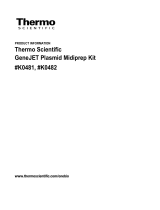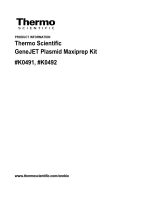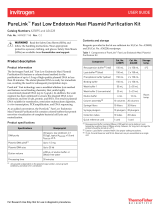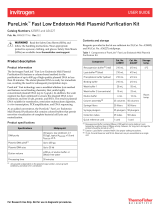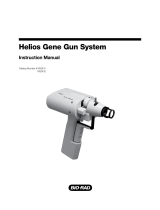Page is loading ...

PRODUCT INFORMATION
Thermo Scientific
GeneJET Plasmid Miniprep Kit
#K0502, #K0503
www.thermoscientific.com/onebio

#K___
Lot _____
CERTIFICATE OF ANALYSIS
Thermo Scientific GeneJET Plasmid Miniprep Kit has been tested in the isolation of pUC19 DNA
from E. coli according to the PURIFICATION PROTOCOL described on p.p. 4-5.
The quality of isolated DNA has been evaluated in a set of tests: spectrophotometric
determination of DNA purity and concentration, agarose gel electrophoresis, digestion with
Thermo Scientific FastDigest restriction endonucleases and automated sequencing.
Quality authorized by: Jurgita Zilinskiene
50
__
Rev.11
} h~

CONTENTS page
COMPONENTS OF THE KIT ................................................................. 2
STORAGE AND STABILITY .................................................................. 2
DESCRIPTION ....................................................................................... 2
PRINCIPLE ............................................................................................ 2
IMPORTANT NOTES ............................................................................. 3
Buffer Preparation ........................................................................ 3
Growth of Bacterial Cultures ......................................................... 3
PURIFICATION PROTOCOLS ............................................................... 4
Protocol A. Plasmid DNA purification using centrifuges…………….4
Protocol B. Plasmid DNA purification using vacuum manifolds……5
TROUBLESHOOTING ........................................................................... 7
SAFETY INFORMATION ....................................................................... 8
REFERENCES ....................................................................................... 9

2
COMPONENTS OF THE KIT
GeneJET Plasmid Miniprep Kit
#K0502
50 preps
#K0503
250 preps
Resuspension Solution
1
5
mL
70
mL
Lysis Solution
15
mL
70
mL
Neutralization Solution*
20
mL
10
0
mL
Wash Solution (concentrated)
20
mL
100
mL
RNase A
(10 mg/
mL
)
0.15
mL
0.7
mL
Elution Buffer (10 mM Tris
-
HCl, pH 8.5)
4
mL
30
mL
GeneJET Spin Columns
50
250
Collection Tubes (2
mL
)
50
250
*Wear gloves when handling Neutralization Solution. Do not add bleach to sample preparation waste.
STORAGE AND STABILITY
GeneJET
™
Plasmid Miniprep Kit can be stored for up to 12 months at room temperature
(15-25°C). For longer storage, it is recommended to keep the kit at 4°C.
If precipitate forms in the buffers during storage, it should be redissolved by incubating the
buffers at 37°C before use.
After addition of RNase A, the Resuspension Solution can be used for 6 months when stored
at 4°C.
Note. Close the bag with GeneJET Spin Columns tightly after each use!
DESCRIPTION
The GeneJET Plasmid Miniprep Kit is designed for rapid and cost-effective small-scale
preparation of high quality plasmid DNA from recombinant E. coli cultures. The kit utilizes an
exclusive silica-based membrane technology in the form of a convenient spin column. Each
GeneJET spin column can recover up to 20 µg of plasmid DNA. The kit can be successefully
used for efficient purification of any size plasmids and cosmids. The actual plasmid yield and
optimal culture volume depend on the plasmid copy number and medium used for cultivation.
PRINCIPLE
Pelleted bacterial cells are resuspended and subjected to SDS/alkaline lysis (1) to liberate the
plasmid DNA. The resulting lysate is neutralized to create appropriate conditions for binding of
plasmid DNA on the silica membrane in the spin column (2). Cell debris and SDS precipitate
are pelleted by centrifugation, and the supernatant containing the plasmid DNA is loaded onto
the spin column membrane. The adsorbed DNA is washed to remove contaminants, and is
then eluted with a small volume of the Elution Buffer (10 mM Tris-HCl, pH 8.5).
The purified plasmid DNA is ready for immediate use in all molecular biology procedures such
as conventional digestion with restriction enzymes, fast digestion with FastDigest
®
restriction
enzymes, PCR, transformation and automated sequencing.

3
IMPORTANT NOTES
Buffer Preparation
• Add the provided RNase A solution to the Resuspension Solution and mix. After addition
of RNase A, the Resuspension Solution can be used for 6 months when stored at 4°C.
• Add ethanol (96-100%) to the Wash Solution prior to first use:
#K0502
50 preps
#K0503
250 preps
Wash Solution (concentrated) 20 mL 100 mL
Ethanol 96% 35 mL 170 mL
Total volume 55 mL 270 mL
• Check the Lysis Solution and the Neutralization Solution for salt precipitation before each
use. Redissolve any precipitate by warming the solution at 37°C, then cool back down to
25°C before use. Do not shake the Lysis Solution too vigorously.
• Both the Lysis Solution and the Neutralization Solution contain irritants. Wear gloves when
handling these solutions. See p. 8 for SAFETY INFORMATION.
• When using EndA+ strains, use Wash Solution I (#R1611) which is available to purchase
separately.
Growth of Bacterial Cultures
• Pick a single colony from a freshly streaked selective plate to inoculate 1-5 mL of LB
medium supplemented with the appropriate selection antibiotic. Incubate for 12-16 hours at
37°C while shaking at 200-250 rpm. Use a tube or flask with a volume of at least 4 times the
culture volume.
• Harvest the bacterial culture by centrifugation at 8000 rpm (6800 × g) in a microcentrifuge
for 2 min at room temperature. Decant the supernatant and remove all remaining medium.
Do not overload the column:
For high-copy-number plasmids (see Table 1), do not process more than 5 mL of
bacterial culture. If more than 5 mL of such a culture are processed, the GeneJET spin
column capacity (20 µg of dsDNA) will be exceeded and no increase in plasmid yield will be
obtained.
For low-copy-number plasmids (see Table 1), it may be necessary to process larger
volumes of bacterial culture (up to 10 mL) to recover a sufficient quantity of DNA.
Table 1. Copy numbers of various vectors
High-copy
300-700 copies per cell
Low-copy
10-50 copies per cell
Very low-copy
up to 5 copies per cell
pUC vectors
pBluescript vectors
pGEM vectors
pTZ vectors
pJET vectors
pBR322 and derivatives
pACYC and derivatives
pSC101 and derivatives

4
PURIFICATION PROTOCOLS
Note
• Read IMPORTANT NOTES on p.3 before starting.
• All purification steps should be carried out at room temperature.
• All centrifugations should be carried out in a table-top microcentrifuge at >12000 ×
××
× g
(10 000-14 000 rpm, depending on the rotor type).
Use 1-5 mL of E. coli culture in LB media for purification of high-copy plasmids.
For low-copy plasmids use up to 10 mL of culture.
Protocol A. Plasmid DNA purification using centrifuges
Step Procedure
1
Resuspend the pelleted cells in 250 µL of the Resuspension Solution. Transfer
the cell suspension to a microcentrifuge tube. The bacteria should be resuspended
completely by vortexing or pipetting up and down until no cell clumps remain.
Note. Ensure RNase A has been added to the Resuspension Solution (as described on p.3)
2
Add 250 µL of the Lysis Solution and mix thoroughly by inverting the tube
4-6 times until the solution becomes viscous and slightly clear.
Note. Do not vortex to avoid shearing of chromosomal DNA. Do not incubate for more than 5
min to avoid denaturation of supercoiled plasmid DNA.
3
Add 350 µL of the Neutralization Solution and mix immediately and thoroughly
by inverting the tube 4-6 times.
Note. It is important to mix thoroughly and gently after the addition of the Neutralization Solution
to avoid localized precipitation of bacterial cell debris.
The neutralized bacterial lysate should become cloudy.
4 Centrifuge for 5 min to pellet cell debris and chromosomal DNA.
5
Transfer the supernatant to the supplied GeneJET spin column by decanting or
pipetting. Avoid disturbing or transferring the white precipitate.
Note. Close the bag with GeneJET Spin Columns tightly after each use!

5
Step Procedure
6
Centrifuge for 1 min. Discard the flow-through and place the column back into the
same collection tube.
Note. Do not add bleach to the flow-through, see p.8 for Safety Information.
7
for
EndA+
strains
only
Optional: use this preliminary washing step only if EndA+ strains which have high
level of nuclease activity are used.
Wash the GeneJET spin column by adding 500 µL of Wash Solution I (#R1611,
diluted with isopropanol) and centrifuge for 30-60 sec. Discard the flow-through.
Note. This step is essential to remove trace nuclease activity.
8
Add 500 µL of the Wash Solution (diluted with ethanol prior to first use as
described on p.3) to the GeneJET
spin column. Centrifuge for 30-60 seconds and
discard the flow-through. Place the column back into the same collection tube.
9 Repeat the wash procedure (step 8) using 500 µL of the Wash Solution.
10 Discard the flow-through and centrifuge for an additional 1 min to remove residual
Wash Solution. This step is essential to avoid residual ethanol in plasmid preps.
11
Transfer the GeneJET
spin column into a fresh 1.5 mL microcentrifuge tube (not
included). Add 50 µL of the Elution Buffer to the center of GeneJET
spin column
membrane to elute the plasmid DNA. Take care not to contact the membrane with
the pipette tip. Incubate for 2 min at room temperature and centrifuge for 2 min.
Note. An additional elution step (optional) with Elution Buffer or water will recover residual DNA
from the membrane and increase the overall yield by 10-20%.
For elution of plasmids or cosmids >20 kb, prewarm Elution Buffer to 70°C before applying to
silica membrane.
12 Discard the column and store the purified plasmid DNA at -20°C.
Protocol B. Plasmid DNA purification using vacuum manifolds
Step Procedure
1 Perform cell lysis and lysate clearing steps according to steps 1 - 4 in Protocol A
on page 4.
2 Prepare the vacuum manifold according to the supplier’s instructions. Place the
GeneJET spin column(s) onto the manifold.
3
Transfer the supernatant to the supplied GeneJET spin column by decanting or
pipetting. Avoid disturbing or transferring the white precipitate.
Note. Close the bag with GeneJET Spin Columns tightly after each use!

6
Step Procedure
4 Apply the vacuum to draw the sample through the column. Switch off the vacuum
after the entire sample has passed through the column.
5
for
EndA+
strains
only
Optional: use this preliminary washing step only if EndA+ strains which have high
level of nuclease activity are used.
Wash the GeneJET spin column by adding 500 µL of Wash Solution I (#R1611,
diluted with isopropanol) and apply the vacuum to draw the solution through the
column.
Note. This step is essential to remove trace nuclease activity.
6 Add 500 µL of the Wash Solution (diluted with ethanol prior to first use as
described on p.3) to the GeneJET
spin column.
7 Apply the vacuum to draw the solution through the column. Switch off the vacuum
after the solution has passed through the column.
8 Repeat the wash procedure (steps 6-7) using 500 µL of the Wash Solution.
9
Transfer the column to collection tube and centrifuge for an additional 1 min to
remove residual Wash Solution. This step is essential to avoid residual ethanol in
plasmid preps.
10
Transfer the GeneJET
spin column into a fresh 1.5 mL microcentrifuge tube (not
included). Add 50 µL of the Elution Buffer to the center of GeneJET
spin column
membrane to elute the plasmid DNA. Take care not to contact the membrane with
the pipette tip. Incubate for 2 min at room temperature and centrifuge for 2 min.
Note. An additional elution step (optional) with Elution Buffer or water will recover residual DNA
from the membrane and increase the overall yield by 10-20%.
For elution of plasmids or cosmids >20 kb, prewarm Elution Buffer to 70°C before applying to
silica membrane.
11 Discard the column and store the purified plasmid DNA at -20°C.

7
TROUBLESHOOTING
Problem Possible cause and solution
Low yield of
plasmid DNA
Bacterial culture too old
Inoculate a fresh batch of antibiotic-containing growth medium with a
freshly-isolated single bacterial colony from an overnight plate.
Cultivate the cells for no more than 16 h at 37°C while shaking in LB
media. Reduce the cultivation time to less than 12 h when using rich
media like TB.
Incomplete lysis of bacterial cells
It is essential that the cell pellet is completely resuspended in the
Resuspension Solution prior to lysis. No cell clumps should be
visible before the addition of the Lysis Solution.
Check the Lysis Solution for salt precipitation before each use.
Redissolve any precipitate by warming the solution to 37°C, then mix
well before use.
Cell cultivation in LB media is recommended. Reduce culture volume
when using a rich cultivation media like TB.
Inefficient elution of DNA
The Elution Buffer must be dispensed to the center of the membrane
for efficient elution.
Contaminated DNA
preparation
Residual ethanol
Ensure that step 10 of the protocol is performed.
RNA in the eluate
Ensure that RNase A is added to the Resuspension Solution before
the first use.
Genomic DNA in the eluate
To avoid shearing and liberation of genomic DNA, do not vortex or
shake the cells during lysis and neutralization (steps 2 and 3), mix by
gentle inversion of the tube.
Do not lyse the cells (step 2) for more than 5 min.
Do not cultivate cells longer than 16 h in LB media or 12 h in TB
media.
Additional band of denatured plasmid
Denatured plasmid DNA migrates ahead of supercoiled DNA. It is
not suitable for following enzymatic manipulations such as restriction
digestion. To avoid denaturation, do not lyse the cells (step 2) for
more than 5 min.

8
SAFETY INFORMATION
Lysis Solution
Danger
Hazard statements:
H314 Causes severe skin burns and eye damage.
H319 Causes serious eye irritation.
Precautionary statements:
P260 Do not breathe dust/fume/gas/mist/vapours/spray.
P303+P361+P353 IF ON SKIN (or hair): Remove/Take off immediately all contaminated
clothing. Rinse skin with water/shower.
P305+P351+P338 IF IN EYES: Rinse cautiously with water for several minutes. Remove
contact lenses, if present and easy to do. Continue rinsing.
P310 Immediately call a POISON CENTER or doctor/physician.
P405 Store locked up.
P501 Dispose of contents/container in accordance with local/regional/national/ international
regulations.
Lysis Solution
C Corrosive
Hazard-determining components of labelling:sodium hydroxide
Risk phrases:
34 Causes burns.
Safety phrases:
20 When using do not eat or drink.
23 Do not breathe gas/fumes/vapour/spray.
26 In case of contact with eyes, rinse immediately with plenty of water and seek medical
advice.
36/37 Wear suitable protective clothing, gloves and eye/face protection.
45 In case of accident or if you feel unwell, seek medical advice immediately (show the label
where possible).
60 This material and its container must be disposed of as hazardous waste.

9
Neutralization Solution
Warning
Hazard statements:
H302 Harmful if swallowed.
H315 Causes skin irritation.
H319 Causes serious eye irritation.
Precautionary statements:
P280 Wear protective gloves/protective clothing/eye protection/face protection.
P305+P351+P338 IF IN EYES: Rinse cautiously with water for several minutes. Remove
contact lenses, if present and easy to do. Continue rinsing.
P321 Specific treatment (see on this label).
P362 Take off contaminated clothing and wash before reuse.
P301+P312 IF SWALLOWED: Call a POISON CENTER or doctor/physician if you feel unwell.
P501 Dispose of contents/container in accordance with local/regional/national/international
regulations.
Neutralization Solution
Xn Harmful
Hazard-determining component of labeling: guanidinium chloride
Risk phrases:
R22 Harmful if swallowed.
R36/38 Irritating to eyes and skin.
Safety phrases
S23 Do not breathe gas/fumes/vapour/spray.
S26In case of contact with eyes, rinse immediately with plenty of water and seek medical
advice.
S36/37 Wear suitable protective clothing and gloves.
S60 This material and its container must be disposed of as hazardous waste.
REFERENCES
1. Birnboim H.C., and Doly, J. (1979) A rapid alkaline lysis procedure for screening recombinant
plasmid DNA. Nucleic Acids Res. 7, 1513 -1522.
2. Vogelstein, B. and Gillespie, D. (1979) Preparative and analytical purification of DNA from agarose.
Proc. Natl. Acad. Sci. USA 76, 615-619.
PRODUCT USE LIMITATION
This product is developed, designed and sold exclusively for research purposes and in vitro use only. The
product was not tested for use in diagnostics or for drug development, nor is it suitable for administration to
humans or animals.
Please refer to www.thermoscientific.com/onebio for Material Safety Data Sheet of the product.
© 2014 Thermo Fisher Scientific, Inc. All rights reserved. All trademarks are the property of Thermo Fisher
Scientific, Inc. and its subsidiaries.
/
